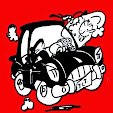By Tracy Letts
Swatting It
http://found111.co.uk/
Strange and horrible things happen in fictional motels: Stabbings in showers in Psycho, paedophilia in Lolita, Thelma and Louise running from the law before a final cliff-hanger, a helpless female saved from mobsters by a Brit secret service agent in the novel The Spy Who Loved Me, drugs and murder in Touch of Evil.
To this litany of weirdness and characters, playwright Tracy Letts added Agnes and Peter in Bug. Pothead Agnes (Kate Fleetwood) is holed up in an Oaklahoma motel room with only a crack pipe for company, avoiding her ex-con ex-husband Jerry (Alec Newman).
That's save for the occasional visit of lesbian friend RC (Daisy Lewis). RC brings along gentle giant (shades of Steinbeck another motel afficianado) Peter (James Norton), seemingly a Gulf War veteran who introduces himself fetchingly saying, "I'm not an axe murderer", only that he "makes people nervous" because he "picks up on things".
He's
certainly no Jack Torrance in The Shining , but gradually Peter starts to drop the
odd line drawing Agnes, already susceptible to National Enquirer type stories, into a world view veering from the comically
conspiratorial to the fatally self-destructive.
And
those things he picks up on? They turn out to have a corporeal manifestation - a
supposed insect infestation where the remedy proves worse than living with
those pesky microscopic critters.
Bug,
mixing Hitchcock with Kafka with Hollywood and comic book scifi horror, a hefty
dollop of the X-Files and even a nightmare possibly from an Ian McEwan novel, premiered in London in 1996.
But
this was also post Watergate and after the fall of the Berlin Wall and very real health fears for Gulf War veterans. And the year of a real Asian beetle infestation in New York
plus journalists revealing the CIA promotion of crack cocaine importation to fund right-wing rebel groups in Nicaragua.
Yet
in the end, the power of Bug the play lies not in state conspiracy, but how far
over the edge the isolated and disappointed - and drug-addled - can be pushed and
nudged into pushing themselves.
Still, lines thrown in at times - "Women aren't my bag" and "I'm playing
devil's advocate" throw into question the delusion and self-knowledge of
the couple. If - in a play written before mass internet usage - the media,
literature, film, the news, even the psychology of acting and the creation of
"character" are the instigators or results of tragedy.
With
the audience as voyeurs on every side and looming plaster beams - there's a
Psycho bathroom in one corner, the seedy motel room door and window at the other -
it's an evening of proximities.
The
changing light (lighting designer Richard Howell) outside is just discernible
through the cheap curtains as Agnes crosses to the mini bar in the third corner
wedged between members of the audience. Indeed viewed from above the bedroom
set may even resemble a bug's compound eye.;)
There
are subtle sound effects from Edward Lewis from the first chirping cricket
(it's not a spoiler to say that this jiminy cricket gets the chop) to the real or imaginary helicopters circling
overhead near the end.
The
Charing Cross Road venue proves perfect for this visceral grunge
production directed by Simon Evans (oh, did we mention James Norton was in it?:)), both as a former art school and as the dilapidated grafitti-strewn
home of Found 111. Whether the play
would have the same impact on a formal proscenium stage is debatable.
Kate
Fleetwood's Agnes and James Norton's Peter crash and burn, gnawing into
themselves, within touching distance and it's the physical nearness which
resonates, Daisy Lewis's RC and Alec Newman's Jerry frame the action of the junkie couple with strong performances. While Carl Prekopp's role of Dr Sweet seems not so much underwritten as
deliberately jarring.
With
a nightmarish comic book quality, TLT and her own little bug(gy) laughed, cringed and gasped spontaneously in the right
places. Be prepared for blood, gore, dentistry beyond Marathon Man, alongside extreme
population pest control and you'll have an enjoyable shlock horror
rollercoaster evening. A green light.




